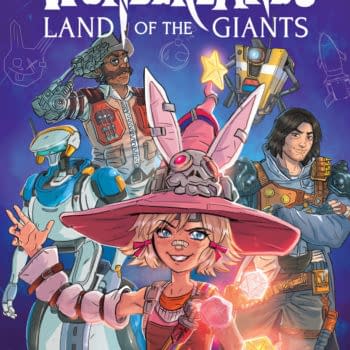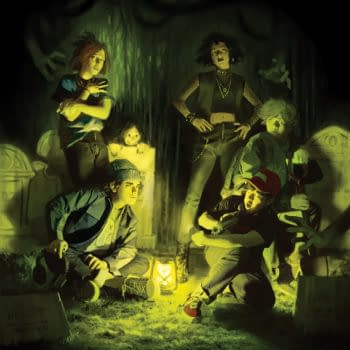Posted in: Comics, Recent Updates | Tagged: A Voice in the Dark: Get Your Gun #1, A Voice in the Dark: Volume 1, Boom! Entertainment, booster gold, butterfly, Comics, dc comics, entertainment, future's end, g.i. joe, harley quinn, idw, superman, Superman Doomed, top cow
Thor's Comic Review Column – Superman Doomed, G.I. Joe, Butterfly, Futures End Month: Week 4, A Voice In The Dark: Volume 1 And Get Your Gun
This Week's Reviews:
Superman: Doomed #2
G.I. Joe #1
Butterfly #1
Booster Gold: Futures End
Superman: Futures End
Futures End #21
Harley Quinn: Futures End
A Voice In The Dark: Volume 1
A Voice In The Dark: Get Your Gun #1
Superman: Doomed #2 ($4.99, DC)
By D.S. Randlett (@dsrandlett)
You've heard a lot about this one over the past few days, I'm willing to bet. The final page of the grand finale to this summer's Superman crossover made some waves, showing the New 52 Brainiac entering Bleed Space (what's "in between" DC's multiverses) and witnessing something that will shake the foundations of the modern DCU: Superman's trunks.
But I'm not here to talk about the implications of the return of that very special pair of drawers. The real question is: How's the comic?
As a whole, the Doomed event has been rather uneven and padded out for length. Now that it's finished, one can say that there are definitely some strong moments and character beats, but Doomed only ever really coheres in its beginning and ending sections. The middle section of the crossover just dragged with nonevent after nonevent. And as a big fan of Greg Pak, Charles Soule, and Aaron Kuder, that hurts to admit. Especially since the good ideas in this crossover were undeniably good, and Pak and Soule at their strongest managed to blend their personal voices quite well.
Most of the stronger ideas were contained in this last issue, probably because all of the cards were finally on the table. Superman, as a character, is at his best when he's making a statement. If I had to boil down the character to one thing, it would be that. He's about finding the courage to find things to stand for. At his core, he is not reactionary (as most other superheroes have been), but proactive in his ideals. Stories that forget this (and there are many) tend not to be among the classics. The New 52 brought in a new version of the character, and DC's approach to their flagship character started awfully schizophrenic, and conflicts between creators and the publisher ensured a rocky start for the line.
I talked a bit about Grant Morrison's run on Action in my Multiversity review last week, so I'll touch on it only briefly, but I think it was odd how that run was supposed to set the tempo for the character. Certainly not from a creative standpoint, as there was a lot there that I think was really dead-on, but certainly from a standpoint of thinking of DC as a comics publisher and commercial entity. That Action run is just not something you'd expect from a subsidiary of a corporation like WB, and it's not even that subversive. But more than that, it's off the beaten path from what the company knows that it can sell, which is basically stuff that either has Batman in it or resembles that line in some way. And that's more or less what the rest of the Superman line resembled.
The creative upheavals in the other half of the line on the main Superman title certainly didn't help matters much, but in the end I think that they were the result of DC trying to form the character more in their current image while it seemed like Action was this Superman comic from an alternate universe. This is all what the latter half of Morrison's Action is about: a corporate entity trying to morph this massive idea into something that it can understand. In the end of that story, Superman is bruised but triumphant, saying "You should see the other guy," while he smiles and pets Krypto the Superdog.
I guess life imitates art, as it seems that Doomed was about purging those last remnants of the change to the Superman property that didn't really work. And it's all amazingly clever if you think about it. The first issue of Doomed was more or less about giving us what we want, or what we think we want. It's a High Noon sort of set up about Superman facing down the inevitable that climaxes with a fight that spans planets and concludes with Superman killing his foe. Sound familiar? But of course there, a rinkle, as upon death Doomsday releases a host of toxic spores that Superman inhales, and these spores start turning him into something like Doomsday as he loses more and more of himself as this infection progresses.
In a way, this series of events turns out to be about making the character into something that he's not, and bringing him back to what we need Superman to be. In other words, what we really want. In Doomed #2, Superman finally comes face to face with Brainiac, who had masterminded this entire affair. His end goal? To recreate the universe into a place where he didn't make one big, fatal mistake. To hit the reset button. It creates an interesting counterpoint to Superman, who recognizes his mistakes here, but desires to move forward rather than attempt to undo them. A statement on the New 52? Maybe, especially given the final page, but Pak and Soule prove that there's plenty of room for this version of Superman to really grow.
Doomed definitely had its weak points, but for something that had the responsibility of cleaning up several messes it has some remarkable highs. Will it be remembered much longer from now? Moments, maybe, but it sure sets the table for a new era of Superman that's truer to the character's core than what we've seen in the past few years. Given the strength of Greg Pak and Aaron Kuder's first storyline in Action, I can't wait to see what's next for this batch of characters now that they've finally established their status quo.
D.S. Randlett lives in the hills of Virginia and takes credit for the reviews that his emaciated twin brother writes while chained to the old radiator. He plays his guitar while biding his time for unsuspecting tourists and thinking about going to grad school.
GI Joe #1 (IDW Publishing)
By Bart Bishop
I'm conflicted. GI Joe is something that I loved as a kid, but have no particular connection to today. Much like Transformers, I'm not offended by the fidelity or quality of the live action movies, new cartoons, or comic book adaptations. When it comes to the comics, I encountered Larry Hama's celebrated, harder-edged Marvel Comics run later in life, but even those were still genre pulp, complete with jetpacks and biker gangs, that weren't afraid to embrace their roots. So how to approach modern GI Joe comics? IDW has continued the trend, started by Image and then Devil's Due with a revival back in 2001, of grounding this silly concept in the real world. It would be easy to dismiss this latest series by Karen Traviss and Steve Kurth that so blatantly tones down the bombast while incorporating topical geo-political themes and analogues of current military conflicts, and yet…it's good. GI Joe #1 kicks off with the storyline "The Fall of GI Joe", and while it's grim aesthetic and square peg, round hole shoehorning of reality collides tonally with holdovers and callbacks to earlier versions, its Tom Clancy-esque approach manages to be thrilling and fresh if a tad jarring.
Not unlike the start of the Image reboot, GI Joe #1 presents a jump into the future. It's been five years since the never-ending war between GI Joe and Cobra went cold, but only Cobra has evolved with the times. Now an international peacekeeping taskforce, Cobra has gone legitimate. They have a consulate in London, a slick PR man in Tomax Paoli, and the world on their side when it comes to vicious fighting between neighboring fictional Baltic countries Schleteva and Galibi, with ethnic Schletevans separatists in the former country and the ubiquitous problem of a potential gas pipeline. Meanwhile, Scarlett, leader of the Joes, is testifying before a Senate committee to determine the "future structure of special forces," and it's not looking good. Amidst the shady world of CIA spooks and crooked politicians, Scarlett and her team have one chance to justify their existence when they're sent on a mission to assassinate Rashidov, the leader of the ethnic Schletevan separatists in Galibi. This is complicated by the training and defection of Isaac, the disillusioned son of Cobra operative Siren, who crosses the border into Galibi to join Rashidov in hopes of bringing back the "true" Cobra.
As far as I know this is Karen Traviss's first foray into comics and her past experience in journalism and prose shines through. Known for her Star Wars, Halo and Gears of War novels, the British author has carved out a respectable corner in speculative military fiction. I actually read a few of her Star Wars books almost ten years ago, back when I read those, and while I respected her consistency in portraying the toils of the average grunt, I always found her a bit self-serious. That hasn't changed with GI Joe, a first issue, of a long-running franchise defined by expanding the back stories of tiny plastic action figures, about soldiers and enemy insurgents in which not a single shot is fired. This could be a complaint, yet Traviss manages to keep the tumblers turning in such an intriguing way that one can't help but wonder how they'll all lock in together. The machinations at work are strong world building, and kudos to Traviss for cramming each page with walls of text that would make Chris Claremont applaud. There's no hot lead or explosions, but there's plenty of action through character interactions and dirty deals. It's a pleasure to see Scarlett as the unquestioned lead, as well, not defined by her sex and respected by her peers. It's unfortunate, however, that she's one of the few characters with any real personality on display.
Kurth's artwork is appropriately stark and worn-in, along the lines of Sean Phillips. He lends military hardware, clothing and gear a nice air of authenticity: clothes are baggy and disheveled without being overly detailed or busy. Concurrently, different tiers of life, such as the stylish Tomax and the world leaders he interacts with are swathed in fitted suits and fashionable attire while Scarlett sports a crisp military uniform in one scene and a redesigned facsimile of her classic outfit when interacting with the Joes. This redesign is a nice concession to the history of the property, although it does stand in rigid contrast to the Baroness's traditional black leather catsuit that she wears in her brief appearance. The look is utilized well, considering the Baroness represents the old Cobra that doesn't fit into this new world, but it can't help but be silly in this context. Furthermore, the Baroness is visually reduced to a sex object, leaning over Tomax's desk leeringly with her body contorted in just the right ways, complete with close-up of Tomax's expression drawing attention to it. It stands out all the more for how well Scarlett and Siren are portrayed without drawing attention to their bodies.
A strong start with an assured creative team, but I can't help but feel it would work better as an original property. As is, there's an inherent tension between the contemporary execution and the past, and it feels like Traviss especially is molding these characters and scenarios to the story she wants to tell rather than working within the sandbox that's been provided.
Editor and teacher by day, comic book enthusiast by night, Bart has a background in journalism and is not afraid to use it. His first loves were movies and comic books, and although he grew up a Marvel Zombie he's been known to read another company or two. Married with a baby girl on the way, he sure hopes this whole writing thing makes him independently wealthy someday. Bart can be reached at bishop@mcwoodpub.com.
Butterfly #1 (Boom!, $2.99)
By Jeb D.
Marvel's Black Widow may be the best-known female secret agent in the comics, but from Peter O'Donnell's Modesty Blaise to Greg Rucka's Queen and Country to Ed Brubaker and Steve Epting's Velvet, there's probably a wider, more interesting range of female spies in the comics than male ones, and Butterfly adds yet another promising one.
Butterfly introduces us to Rebecca Faulkner, the ex-CIA protagonist of an espionage tale that steps back from Bond and Bourne in favor of a mixture that draws its attention to the detail of tradecraft from LeCarre and its modern urgency from Homeland. Rebecca's capably professional, angry though dutiful about doing a Cold War job in a post-glasnost world, but when she's betrayed and abandoned, naturally everything goes to shit. The reader will probably see the "twist" coming that occurs halfway through the issue, but it's well executed, bringing a fresh perspective on Rebecca's character and background, and opening up her world for us.
Rebecca's narration is terse and straightforward, sometimes a bit dry, but writers Arash Amel and Marguerite Bennett provide us a welcome change from the usual attempt to make female protagonists talk like clichéd hard-boiled tough guys. There's a lot of layers here, and a few jumps in the plotting that may be cleverly hidden story points but might just as easily be sloppy editing; given the change of perspective in the issue's second half, I'm a bit concerned that there may be more story here than four issues can properly support; it might have been artistically optimal (if commercially riskier) to shoot for six issues, instead.
The art from Antonio Fuso is beautifully in tune with the script: the pacing of the story is careful and deliberate, the paneling confidently leaves space to lay out the tradecraft, twists, and betrayals, with action sequences that are quick and tough. His angular style is just rough enough to underline the ambiguities inherent in Rebecca's profession by keeping certain details vague, while bringing others into focus. He's adept at adding clarity when the script gets obscure (though there are a few panels set in a cold shipyard where the depiction of Rebecca's frosted breath looks like a scrap of paper someone forgot to brush off the page).
It's sort of odd, given the dreary inevitability of sequel-itis in pop culture, but Butterfly is the rare case where I'm actually going to be pretty disappointed if Amel and Bennett don't have the opportunity to follow up these four issues with more, even if it doesn't need to become an ongoing series; by the end of this first issue, Rebecca's world, and cast of characters, has opened up significantly, and I'd like the story to have a chance to breathe before it climaxes.
Jeb D. is a boring old married guy whose comics background includes attending the very first San Diego Comic-Con, being lectured on Doc Savage by Jim Steranko, and fetching an ashtray for Jack Kirby. After a quarter-century in the music biz, he pursues more sedate activities these days, and will certainly have a blog or Facebook account or some such thing one day.
Futures End Month Week 4 (DC Comics $2.99/$3.99)
By Graig Kent
The final week of Futures End Month yields some of the most interesting reading, not just for the story of Futures End, but the overall direction of the DC Universe for the next six months (at least). There's a convergence happening this week, starting with Superman: Doomed #2 (as Rich Johnston teased/spoiled last week). That series is not only dovetailing into the next issue of Futures End, but also seems to be teasing the "band-aid event" taking place early next year which may (or may not) see the return of the old DC Universe that Flashpoint disposed of.
Booster Gold: Futures End is the only book in Futures End Month to not be tied to an ongoing series, but it picks up where previous Booster appearances in Justice League International and All-Star Western left off. The issue finds Booster bouncing around time and between dimensions including the Gotham By Gaslight Elseworld, the 31st century (or rather A 31st century), an alternate Earth comprised of the Charlton heroes, and Kamandi's future/world. Booster meets and alternate version of himself in a prison, perhaps trapped by Brainiac or Brother Eye (certainly whatever nefarious force is in full control of the future as seen in the Futures End zero issue) who is looking for the key to the Vanishing Point — a powerful time travel gateway.
Dan Jurgens, being an architect of Futures End and one of DC's go-to-guys for over two decades, seems to have solid insight into the overall plan for the DCU for the next little while (I can't help but think that Morrison's work on Multiversity is shoehorned into here as well). Jurgens has orchestrated big events in the past (Death of Superman, Zero Hour) and participated in many others, but this is easily his most assured — and playful — tie-in. Not only does Jurgens bounce Booster from one playspace to the next, he's joined by a different artist for each jump including Moritat, Steve Lightle, Ron Frenz and Brett Booth. It's a dizzying ride, but an extremely fun one for longtime DCU fans, but may prove a little puzzling to New 52 reader, although the overall impact should stimulate interest towards what the future holds.
I can be pretty hard on the man, but Jurgens delivers a solid 1-2 punch of Futures End tie-ins this week. Superman: Futures End picks up from the fallout of Futures End #17, where the identity of the masked Superman was revealed, and splashed all over the internet by Lois Lane. It nicely expand a sub-plot (or two) and invest a bit more time and space in getting into the characters heads and exploring their motivations (something the weekly doesn't have a lot of space for), as well as filling in some background blanks to events seen in the main series. Most exciting about this issue is art from Lee Weeks (with ace colorist Dave McCaig). While Weeks' dark, shadowy, line-heavy style may not be the most suited for Superman, it's been some time since I've last seen his work, and it looks as fantastic as ever. His grounded sense of the natural world juxtaposes nicely against the dynamism of his super-figures performing mighty deeds. McCaig's color use is very muted, primarily highlighted by orangey-reds and ambers, giving the 5-years-from-now future a tainted, grimy sense, but not completely dark and bleak. It may not be strictly the most necessary book from Futures End Month, but it is the most complimentary. If you're reading the weekly it's a must-get.
Meanwhile, in the main book, Futures End #21, we are finally given somewhat of a run-down on the Earth War — a very high level overview at least — through that hoary old cliche of one character relating the events to another character, including a large portion of story they should already know. In this case, Earth 2's Red Arrow heavily exposits to Big Barda the story of their planet's war against Apokolips, the evacuation to Earth 1, and dragging the war to another planet. It's a bit heavy-handed, but overall a necessary break-point to draw all the threads together. Cully Hamner is on board to illustrate the 20 page montage in widescreen, stacking 4 or five long panels per page creating a sweeping effect while providing plenty of room for Red Arrow's narrative text. While it certainly doesn't fill in all of the blanks, it does enough to satiate the curious mind and allow the story to progress. Next issue will see the beginning of the assault on Cadmus Island and possibly how Brainiac's thread from Superman: Doomed ties in.
Finally, for this week and month, there's Harley Quinn: Futures End. After her loathesome transformation and death in Suicide Squad: Futures End earlier this month, I was wondering exactly how DC was going to handle Harley's grotesque fate in her own title. Simple answer (and wise solution) is they ignored it altogether. I don't know if that's supposed to imply that Harley Quinn (the book) is set in another world of DC's Multiverse (perhaps the comedy world that houses Ambush Bug, Hero Hotline and Inferior 5) or just that Harely Quinn never plays by the rules. This issue finds Harley, five years later, taking a flight (in cargo, no less) only to crash land on an island that worships the Joker. The natives honor her as their queen and prepare her for the wedding-come-sacrificial ceremony, and things go further awry from there.
You can't take Harley Quinn seriously, as is the point, and getting bent out of shape about continuity is wasted energy. It's a Joe Versus The Volcano-meets-Castaway romp (will Harley make her way through all of Tom Hanks' greatest hits…she meets Aquaman at the end so is Splash in her future?) that's entertaining, full stop. It doesn't need to be anything more than that. Story by Connor and Palmiotti, terrifically playful art from Chad Hardin, this could be today, five years later, or 20 years later, it doesn't make that much of a difference.
Next week: something other than Futures End
Graig Kent is pressed for time. Sparse tweeting @thee_geekent, corgi pictures at tacomblur.tumblr.com
A Voice In The Dark: Volume 1 (Top Cow, $19.99)
A Voice In The Dark: Get Your Gun #1 (Top Cow, $3.99)
By Jeb D.
I was tempted to begin this review by telling you "Don't buy A Voice In The Dark: Get Your Gun #1", but that would just be grandstanding: what I really mean is "Buy this comic… but put it aside till you've finished reading the series' first trade collection."
In the year or so before the Thor's Comic Review column moved over to Bleeding Cool, I was evangelizing for a pair of black and white horror comics, whose focus on their female characters extended beyond disrobing or dismembering them. The "big name" book was Terry (Strangers in Paradise) Moore's Rachel Rising, a macabre, funny, mystical/historical onion that peels itself deliciously back, layer by layer. If Moore's name was what sold me on Rachel Rising, sight unseen, it was the online… well, "buzz" might be an exaggeration; let's say the "murmuring" (largely here at Bleeding Cool)… about A Voice In the Dark that got me to take a chance on it. It was suggested that, despite its borrowing a few of its tropes from various of the "serial killer" genre, A Voice in the Dark was not quite like any comic I'd read before; that's true in the most positive sense. This week, the series begins its newest story arc with the time-tested renumbering approach, but I really don't advise new readers to start here (and regular readers of the series will have to wait a few paragraphs while I bring the newbies up to speed before covering the new issue).
One thing that links superhero comics to things like TV cop and doctor shows is that the framework is generally built around characters who encounter situations of conflict as part of their day to day profession (or avocation, hobby, destiny, whatever); Peter Parker doesn't have weird supervillains randomly show up at his house, he's out there looking for trouble. So, while we can endlessly debate the fine points of continuity, you can pretty much grab a Spider-Man trade off the shelf at random with the assumption that whatever you may have missed leading up to that point was just a variation on a Spider-Man story you've read in the past.
But serialized storytelling featuring more or less "normal" folks—that is, those who are not specifically tasked with confronting crime or disease on a daily basis—doesn't lend itself to that sort of tidy open-and-shut storytelling: most of us only encounter our Doc Ocks once in a lifetime, if ever. So while writer-artist Larime Taylor provides a brisk recap of the previous seven issues inside the front cover of A Voice In The Dark: Get Your Gun #1,", his rather stark summary can't even hint at the elegant way he's crafted his chilling story up to this point, and new readers would miss out on the measured buildup and occasional gutpunches.
Instead, take a chance and snag that first trade collection. In it, you'll meet our protagonist, Zoey Aarons, a mixed-race young woman whose working-class parents have sent her to school at a liberal-arts college in California. Zoey's not a typical college kid, though: she's a murderer, and is convinced that she will kill again. That's not a spoiler; Zoey's first line in the comic is: "Dear Diary: It's been 72 days since I killed someone."
In fact, Zoey's inner monologue is a back-and-forth dialog with her darkest inner self, as she lays out for the reader the backstory behind her (as-yet unsolved) crime, and the thorny familial relationships that are going to run headlong into her impulse to kill again. She hopes that the call-in show that she begins hosting at the college radio station will provide an outlet for her darker side, but she quickly finds, unsurprisingly, that two-way communication with the outside world may make her a magnet for those just as disturbed as she is.
For all the stark simplicity of the backgrounds and design, Taylor has a great eye for the unconscious gestures and fidgets we exhibit in times of stress: characters polish glasses, chew lips, peek uncertainly around doors; and his varied, largely female cast, is composed of realistically-shaped bodies and varied ethnicities. Taylor's art occasionally suggests the starkness of Los Bros Hernandez or Terry Moore, but without Moore's gift for facial expression: though all the characters in A Voice in the Dark are well-realized and distinctive, they're defined not by facial reactions, but through easy, naturalistic dialog, that captures the hesitancy of that transitional period in a young person's life, as they take their first steps out of the nest.
The striking art, gruesome storyline, and decidedly non-traditional cast would be strong enough recommendations for the book, but the character of Zoey really holds it all together: she exhibits the ability to be both resigned to, and horrified by, the person she sees in the mirror, and has a dry wit to go along with it (during a meeting with the manager of the radio station, after receiving some unexpectedly good news, Zoey muses "I'm feeling real bad about fantasy-strangling her now").
For those who have been reading A Voice In The Dark up to this point, the most significant change you'll notice in the first installment of A Voice In The Dark: Get Your Gun #1" will be the addition of colors from Jay Savage (Taylor's wife Sylv has previously colored the book's covers): it's an interestingly muted palette, rather like slightly muddy watercolor; color may have been added to enhance the book's commercial prospects, but it adds texture without undercutting the strength of Taylor's art. I won't go into plot details, since some folks reading this may not be caught up yet, but the book opens with a pretty intense flash-forward scene, then drops back to show us Zoey's first meeting with a character who readers of the series have been, well… "dying" to meet. It's very well paced, with the abrupt contrast of the immediate danger of the opening sequence with the various menaces, seen and unseen, growing around Zoey, underlined by the sharply scripted dialog.
A comic as good as A Voice In The Dark is remarkable on its own, but it's also got a backstory that is inescapable: the writer and artist of this admirably diverse comic is a white dude with an aging-hippie ponytail, who has a disability that robs him of the use of his arms, and forces him to do all his work on computer, with a Wacom tablet, by means of a stylus held between his teeth; he's used photographs he's taken himself to model his cast of characters. A Voice In The Dark would be a helluva piece of work coming from a fully-abled woman of color; for a physically-challenged white male, it's a noteworthy achievement. More to the point, though, it's a gripping series that will have you eager for more, even if you knew nothing of the author's personal story.
























